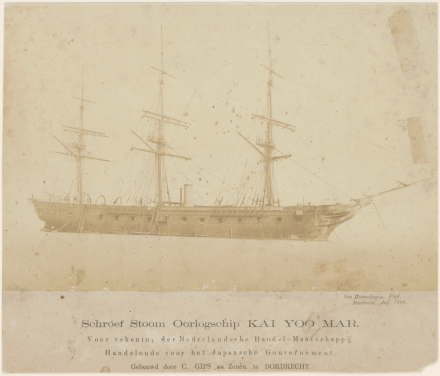History
A brief history
In order to strengthen the naval force of the shōgunate, the Japanese government ordered a steam-driven warship from the Netherlands in 1863. When the Kaiyō Maru was launched in Dordrecht in 1865, she was the largest wooden warship ever built in the Netherlands. The Kaiyō Maru was one of seven steamships that played a major role in the naval battles of the Boshin War (1868-1869, the conflict between the shōgunate and the imperial government that wanted to take over power from the Shōgun). The remainder of the shōgunate fleet, with the Kaiyō Maru as its flagship, fled up north to Hokkaido. The intent was to launch a counter-attack on the somewhat inferior Imperial Japanese Navy, but before the attack could commence, the Kaiyō Maru was wrecked in a typhoon on 15 November 1868. Demoralised by the loss of the Kaiyō Maru, the fleet lost the battle to the Imperial Japanese Navy.

Description
Shipwright: Cornelis Gips and Sons, Dordrecht, Netherlands.
Owner: Tokugawa Shōgunate Navy.
Propulsion: coal-fired steam engine, sails (three masts).
Armament: 18 cannon with 16 cm guns, 8 30-pound cannon, later 5 additional cannon.

| Length | 237 feet (72.2 m) |
|---|---|
| Width | 42 ¾ feet (13 m) |
| Draft | 21 feet (6.4 m) |
| Tonnage | 2632 ton |
Status
Partial excavations
The shipwreck was rediscovered in 1968. Due to lack of funding however, only a few items were initially recovered (see Araki, 1985). Full-scale excavation began in 1975, though it took until 1985 to end the work on the site. To this day, a remainder of the wreck still lies within the confines of Esashi harbour.
Replica
A replica of the Kaiyō Maru was constructed in 1990 and remains on display at the Esashi docks where it is used as a tourist attraction, showing excavated remains of the actual ship.
References
- S. Araki (1985).
Ruins on the Ocean Floor (Salvaging the Kaiyo Maru).
American Academy of Underwater Sciences, 1985 (17). - J. de Vries (2000).
De Geboorte van de Japanse Marine. In L. Blussé, R. Remmelink & I. Smits (Eds.), Bewogen betrekkingen: 400 jaar Nederland-Japan.
Teleac/N.o.t. - Kaiyou Maru Youth Center.